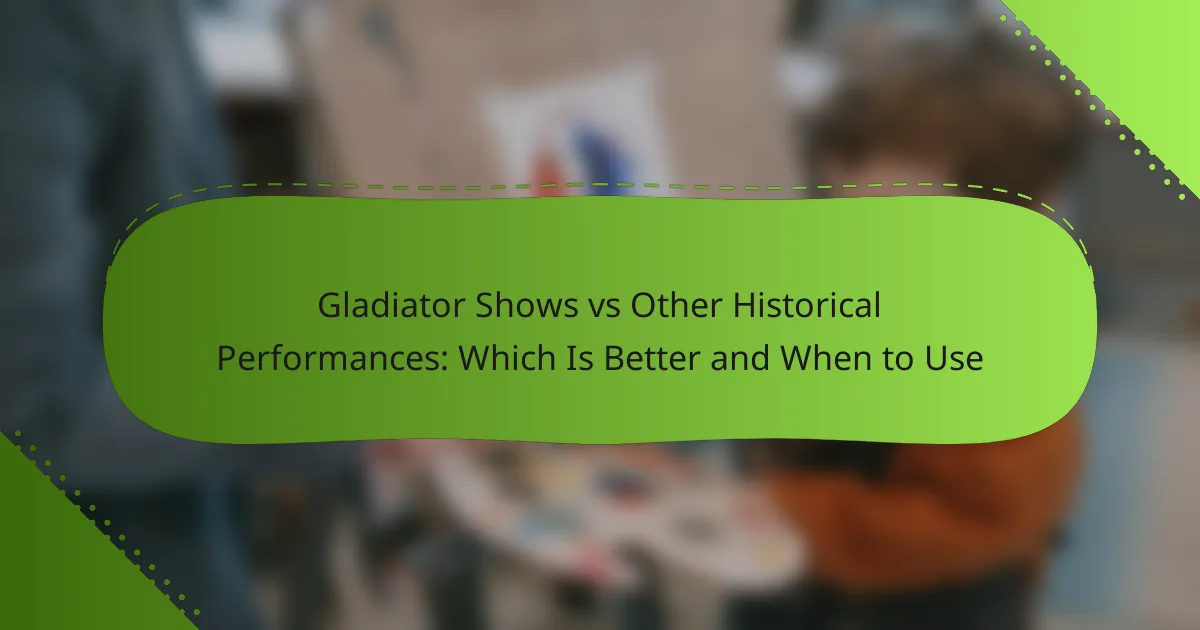Gladiator shows offer a unique combination of thrilling combat and historical education, captivating audiences with dynamic performances that reflect ancient Roman culture. In contrast, other historical performances often emphasize storytelling and cultural representation. Understanding these distinctions is essential for selecting the most appropriate type of performance for entertainment or educational purposes.

What are the key differences between Gladiator shows and other historical performances?
Gladiator shows primarily revolve around combat and survival, while other historical performances often focus on storytelling and cultural representation. Understanding these differences can help in choosing the right type of performance for entertainment or educational purposes.
Gladiator shows focus on combat and survival
Gladiator shows are characterized by their intense combat scenarios, where trained fighters engage in battles for survival and glory. These performances often recreate historical events from ancient Rome, emphasizing physical prowess and the struggle for life in a highly charged atmosphere.
When considering a gladiator show, it’s essential to assess the safety measures in place, as these events can involve real weapons and physical confrontations. Audiences should be prepared for a visceral experience that highlights the brutality and excitement of ancient combat.
Other performances emphasize storytelling and culture
In contrast, other historical performances typically prioritize narrative and cultural themes, often using drama, music, and dance to convey messages. These shows may depict significant historical events, folklore, or traditional practices, allowing audiences to engage with the culture being represented.
When selecting a performance of this nature, consider the educational value and the depth of storytelling. Such performances can provide insights into the values, beliefs, and customs of different societies, making them suitable for audiences seeking a more reflective experience.

When are Gladiator shows most effective?
Gladiator shows are most effective during events that seek to engage audiences with thrilling, historical entertainment. Their impact is maximized when integrated into themed festivals or educational settings, where the context enhances the experience and understanding of ancient Roman culture.
During themed events and festivals
Gladiator shows thrive in themed events and festivals, where they can draw large crowds and create an immersive atmosphere. These performances can be scheduled as highlights of the event, often accompanied by period costumes, music, and food to enhance the overall experience.
When planning such events, consider the venue’s capacity and the audience’s interests. A successful festival might feature multiple performances throughout the day, allowing attendees to engage with the show at their leisure. Collaborating with local vendors for themed merchandise can also boost the event’s appeal.
In educational settings for historical engagement
In educational contexts, gladiator shows serve as a dynamic tool for historical engagement, making ancient history tangible for students. Schools and museums can host demonstrations that not only entertain but also educate about Roman society, military tactics, and cultural practices.
To maximize educational value, these shows should be accompanied by discussions or workshops that delve into the historical significance of gladiators. Incorporating interactive elements, such as Q&A sessions or hands-on activities, can further enhance learning outcomes and foster a deeper appreciation for the subject matter.

What are the benefits of choosing Gladiator shows?
Choosing Gladiator shows offers a unique blend of thrilling entertainment and historical education. These performances captivate audiences with their dynamic action while providing insights into ancient Roman culture and societal values.
High audience engagement and excitement
Gladiator shows are designed to be highly engaging, often featuring dramatic combat, elaborate costumes, and immersive storytelling. The adrenaline rush from watching live performances keeps audiences on the edge of their seats, making it an ideal choice for events aimed at maximizing entertainment value.
To enhance engagement, consider incorporating interactive elements such as audience participation or themed events. This can elevate the experience, drawing in larger crowds and creating memorable moments that resonate with attendees.
Unique historical insight and entertainment
Gladiator shows provide a fascinating glimpse into the past, showcasing the values, struggles, and entertainment practices of ancient Rome. They often highlight the significance of gladiators in society, portraying them as both heroes and entertainers.
Incorporating educational components, such as brief historical narratives or expert commentary, can enrich the audience’s understanding. This approach not only entertains but also informs, making Gladiator shows a compelling choice for schools, festivals, and cultural events.

What are the limitations of Gladiator shows?
Gladiator shows have several limitations, including historical inaccuracies and the potential to promote violence. These factors can detract from their educational value and impact on audiences.
Potential for misrepresentation of history
Gladiator shows often present a dramatized version of ancient Rome that may not accurately reflect historical events or societal norms. This misrepresentation can lead audiences to form misconceptions about the culture, politics, and daily life of the time.
For example, while gladiatorial combat was a part of Roman entertainment, the context surrounding these events—such as the social status of gladiators and the reasons for their participation—are frequently oversimplified or ignored. This can result in a skewed understanding of history.
Risk of glorifying violence
One significant limitation of gladiator shows is their tendency to glorify violence as entertainment. This portrayal can desensitize audiences to real-life aggression and conflict, potentially leading to a normalization of violent behavior.
When violence is presented as thrilling or heroic, it may overshadow the brutal realities faced by those involved. This can create a dangerous narrative that trivializes the consequences of violence in society.

How do Gladiator shows compare to theatrical performances?
Gladiator shows and theatrical performances serve different purposes in entertainment, with gladiator shows emphasizing physical action and combat, while theatrical performances prioritize storytelling and emotional engagement. Choosing between them depends on the audience’s preferences and the desired impact of the event.
Gladiator shows are more action-oriented
Gladiator shows are designed to captivate audiences with intense physicality and thrilling combat. These performances often feature skilled fighters engaging in battles that showcase strength, agility, and strategy. The focus is on visual spectacle, making them ideal for audiences seeking excitement and adrenaline.
When organizing a gladiator show, consider the venue’s layout to enhance visibility and engagement. Outdoor arenas or large auditoriums can accommodate larger crowds and provide an immersive experience. Additionally, incorporating elements like sound effects and dramatic lighting can heighten the overall impact.
Theatrical performances focus on narrative depth
Theatrical performances prioritize storytelling, character development, and emotional resonance. These shows often explore complex themes and engage audiences through dialogue, music, and visual artistry. The aim is to provoke thought and evoke feelings, making them suitable for those who appreciate nuanced narratives.
When planning a theatrical performance, ensure that the script is well-crafted and the actors are skilled in delivering their roles. Consider the use of set design and costumes to enhance the storytelling experience. Engaging the audience through interactive elements, such as post-show discussions, can also deepen their connection to the narrative.

What are the best practices for organizing a Gladiator show?
To organize a successful Gladiator show, focus on historical accuracy, audience engagement, and safety protocols. These elements will enhance the experience for attendees while respecting the cultural significance of the performances.
Ensure historical accuracy in portrayal
Maintaining historical accuracy is crucial for authenticity in a Gladiator show. Research the era, costumes, and combat techniques used by Roman gladiators to create a believable environment. This includes using appropriate weapons, armor, and staging that reflect the time period.
Consider consulting historians or experts in ancient Rome to validate your portrayal. This not only enriches the performance but also educates the audience about the realities of gladiatorial combat, enhancing their overall experience.
Incorporate audience interaction for immersion
Engaging the audience can significantly enhance their experience during a Gladiator show. Incorporate elements such as interactive voting on match outcomes or allowing audience members to participate in certain activities, like training demonstrations. This creates a more immersive atmosphere.
Additionally, consider using guided tours or pre-show discussions to involve the audience further. These interactions can help bridge the gap between the performers and spectators, making the event more memorable and enjoyable for everyone involved.

When should other historical performances be used instead?
Other historical performances should be used when the goal is to educate or celebrate diverse cultural narratives rather than to entertain through combat. These performances can effectively convey historical contexts, social issues, and artistic expressions that resonate with specific audiences.
For educational purposes in classrooms
In educational settings, historical performances can serve as powerful tools for teaching. They can illustrate significant events, cultural practices, and societal norms from various periods, making history more relatable and engaging for students. For instance, reenactments of significant historical events or traditional storytelling can help students grasp complex ideas and foster critical thinking.
When implementing these performances in classrooms, consider the age group and learning objectives. Choose performances that align with the curriculum and encourage active participation. This approach not only enhances understanding but also promotes empathy and cultural awareness among students.
At cultural festivals highlighting diverse histories
Cultural festivals provide an ideal platform for showcasing historical performances that celebrate various heritages. These events can feature traditional dances, music, and theatrical presentations that reflect the unique stories of different communities. Such performances foster appreciation for cultural diversity and promote inclusivity.
When organizing or attending these festivals, prioritize performances that authentically represent the cultures being showcased. Collaborate with community members to ensure accurate portrayals and avoid stereotypes. This not only enriches the festival experience but also honors the histories and traditions of the participating cultures.

What emerging trends are shaping historical performances?
Emerging trends in historical performances include the integration of technology and a focus on immersive experiences. These trends are reshaping how audiences engage with history, making performances more interactive and accessible.
Incorporation of technology for enhanced experiences
The incorporation of technology in historical performances allows for enhanced storytelling and audience engagement. Techniques such as augmented reality (AR) and virtual reality (VR) can transport viewers to different eras, providing a more immersive experience.
For instance, using AR apps, audiences can see historical figures and events come to life in their surroundings. This technology can be particularly effective in outdoor performances or historical sites, where viewers can interact with their environment in real-time.
When considering technology integration, it’s essential to balance tech use with the authenticity of the performance. Over-reliance on technology may detract from the historical narrative, so ensure that it complements rather than overshadows the story being told.
